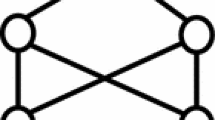Abstract
Given a connected graph G, let a Δ T-spanning tree of G be a spanning tree of G of maximum degree bounded by Δ T. It is well known that for each Δ T ≥ 2 the problem of deciding whether a connected graph has a Δ T-spanning tree is NP-complete. In this paper we investigate this problem when additionally connectivity and maximum degree of the graph are given. A complete characterization of this problem for 2- and 3-connected graphs, for planar graphs, and for Δ T = 2 is provided.
Our first result is that given a biconnected graph of maximum degree 2Δ T - 2, we can find its Δ T-spanning tree in time O(m + n 3/2). For graphs of higher connectivity we design a polynomial-time algorithm that finds a Δ T-spanning tree in any k-connected graph of maximum degree k(Δ T − 2) + 2. On the other hand, we prove that deciding whether a k-connected graph of maximum degree k(Δ T - 2) + 3 has a Δ T-spanning tree is NP-complete, provided k ≤ 3. For arbitrary k ≥ 3 we show that verifying whether a k-connected graph of maximum degree k(Δ T - 1) has a Δ T-spanning tree is NP-complete. In particular, we prove that the Hamiltonian path (cycle) problem is NP-complete for k-connected k-regular graphs, if k > 2. This extends the well known result for k = 3 and fully characterizes the case Δ T = 2.
For planar graphs it is NP-complete to decide whether a k-connected planar graph of maximum degree Δ G has a Δ T-spanning tree for k = 1 and Δ g > Δ T ≥ 2, for k = 2 and Δ G > 2(Δ T -1) ≥ 2, and for k = 3 and Δ G > Δ T = 2. On the other hand, we show how to find in polynomial (linear or almost linear) time a Δ T-spanning tree for all other parameters of k, Δ G, and Δ T.
Partially supported by EU ESPRIT Long Term Research Project 20244 (ALCOM-IT), DFG Leibniz Grant Me872/6-1, and DFG Project Me872/7-1.
Preview
Unable to display preview. Download preview PDF.
Similar content being viewed by others
References
D. Barnette. Trees in polyhedral graphs. Canadian J. Mathematics, 18:731–736, 1966.
D. Bauer, S. L. Hakimi, and E. F. Schmeichel. Recognizing tough graphs is NP-hard. Discrete Applied Mathematics, 28:191–195, 1990.
B. Bollobás. Extremal Graph Theory. Academic Press, London, 1978.
P. M. Camerini, G. Galgiati, and R. Maffioli. Complexity of spanning tree problems, I. European Journal of Operation Research, 5:346–352, 1980.
Y. Caro, I. Krasikov, and Y. Roditty. On the largest tree of a given maximum degree in a connected graph. Journal of Graph Theory, 15:7–13, 1991.
N. Chiba and T. Nishizeki. The Hamiltonian cycle problem is linear-time solvable for 4-connected planar graphs. Journal of Algorithms, 10:187–211, 1989.
M. Fairer and B. Raghavachari. Approximating the minimum-degree Steiner tree to within one of optimal. Journal of Algorithms, 17:409–423,1994. Also in ACM-SIAM SODA 1992.
M. R. Garey and D. S. Johnson. Computers and Intractability: A Guide to the Theory of NP-completeness. Freeman, New York, 1979.
M. R. Garey, D. S. Johnson, and R. E. Tarjan. The planar Hamiltonian circuit problem is NP-complete. SIAM Journal on Computing, 5(4):704–714, 1976.
M. X. Goemans and D. P. Williamson. A general approximation technique for constrained forest problems.SIAM Journal on Computing, 24(2):296–317, 1995.
H. Nagamochi and T. Ibaraki. A linear-time algorithm for finding a sparse k-connected spanning subgraph of a k-connected graph. Algorithmica, 7:583–596, 1992.
B. Jackson and T. D. Parsons. On r-regular r-connected non-Hamiltonian graphs. Bulletin of Australian Mathematics Society, 24:205–220, 1981.
D. S. Johnson. The NP-completeness column: An ongoing guide. Journal of Algorithms, 6:434–451, 1985.
S. Khuller and B. Raghavachari. Improved approximation algorithms for uniform connectivity problems. In Proceedings of the 27 ACM STOC, pp. 1–10, 1995.
S. Khuller, B. Raghavachari, and N. Young. Low degree spanning trees of small weight. SIAM Journal on Computing, 25(2):355–368, 1996.
S. Khuller and U. Vishkin. Biconnectivity approximations and graph carvings. Journal of the ACM, 41(2):214–235, 1994.
T. Lukovski and W.-B. Strothmann. Decremental biconnectivity on planar graphs. Manuscript, 1997.
G. H. J. Meredith. Regular n-valent n-connected nonHamiltonian non-n-edge-colorable graphs. Journal of Combinatorial Theory Series B, 14:55–60, 1973.
V. Neumann-Lara and E. Rivera-Campo. Spanning trees with bounded degrees. Combinatorica, 11(1):55–61, 1991.
C. H. Papadimitriou and M. Yannakakis. The complexity of restricted spanning tree problems. Journal of the ACM, 29(2):285–309, 1982.
M. Rauch. Improved data structures for fully dynamic biconnectivity. Full version. A preliminary version appeared in Proceedings of the 26th ACM STOC, 1994.
M. Rauch Henzinger and V King. Fully dynamic biconnectivity and transitive closure. In Proceedings of the 36th IEEE FOCS, pp. 664–673, 1995.
D.D. Sleator and R.E. Tarjan. A data structure for dynamic trees. Journal of Computer and System Sciences 26:362–391, 1983.
W.-B. Strothmann. Constructing 3-trees in 3-connected planar graphs in linear time. Manuscript, 1996.
S. Win. On a connection between the existence of k-trees and the toughness of a graph. Graphs and Combinatorics, 5:201–205, 1989.
Author information
Authors and Affiliations
Editor information
Rights and permissions
Copyright information
© 1997 Springer-Verlag Berlin Heidelberg
About this paper
Cite this paper
Czumaj, A., Strothmann, WB. (1997). Bounded degree spanning trees. In: Burkard, R., Woeginger, G. (eds) Algorithms — ESA '97. ESA 1997. Lecture Notes in Computer Science, vol 1284. Springer, Berlin, Heidelberg. https://doi.org/10.1007/3-540-63397-9_9
Download citation
DOI: https://doi.org/10.1007/3-540-63397-9_9
Published:
Publisher Name: Springer, Berlin, Heidelberg
Print ISBN: 978-3-540-63397-6
Online ISBN: 978-3-540-69536-3
eBook Packages: Springer Book Archive



